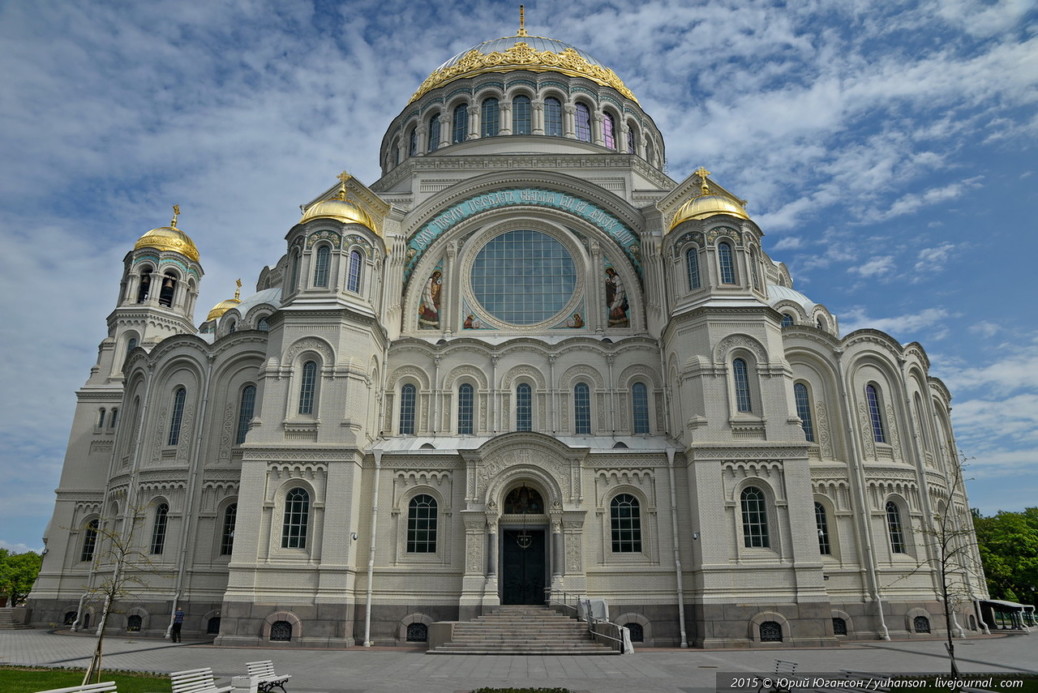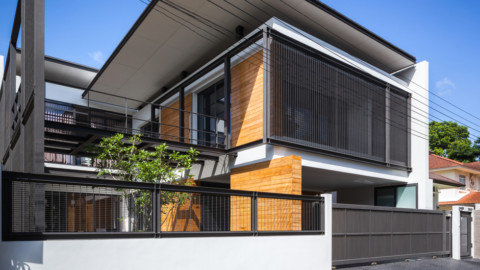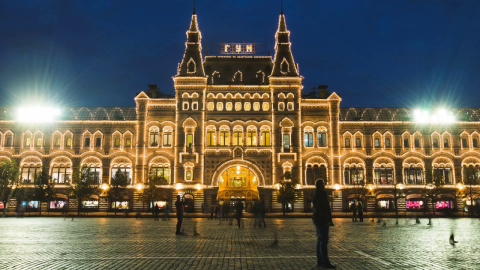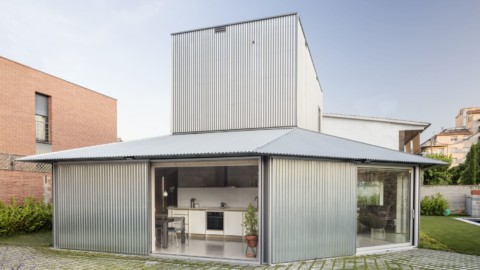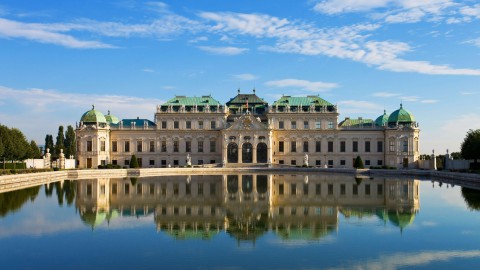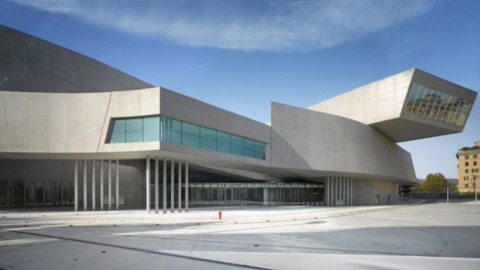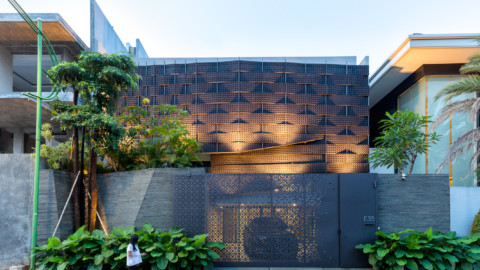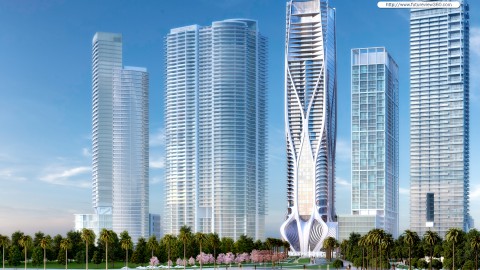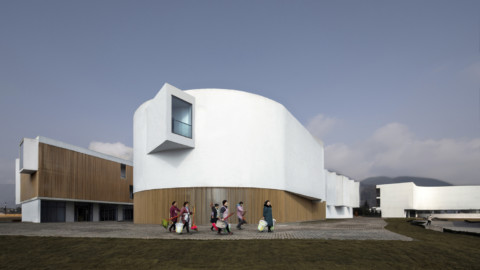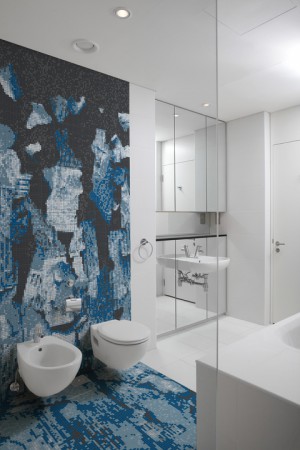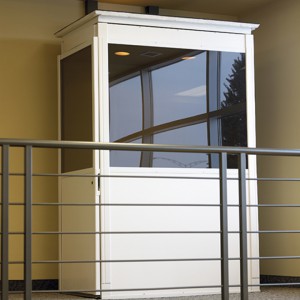Kronstadt Naval Cathedral 克朗斯塔特海軍大教堂
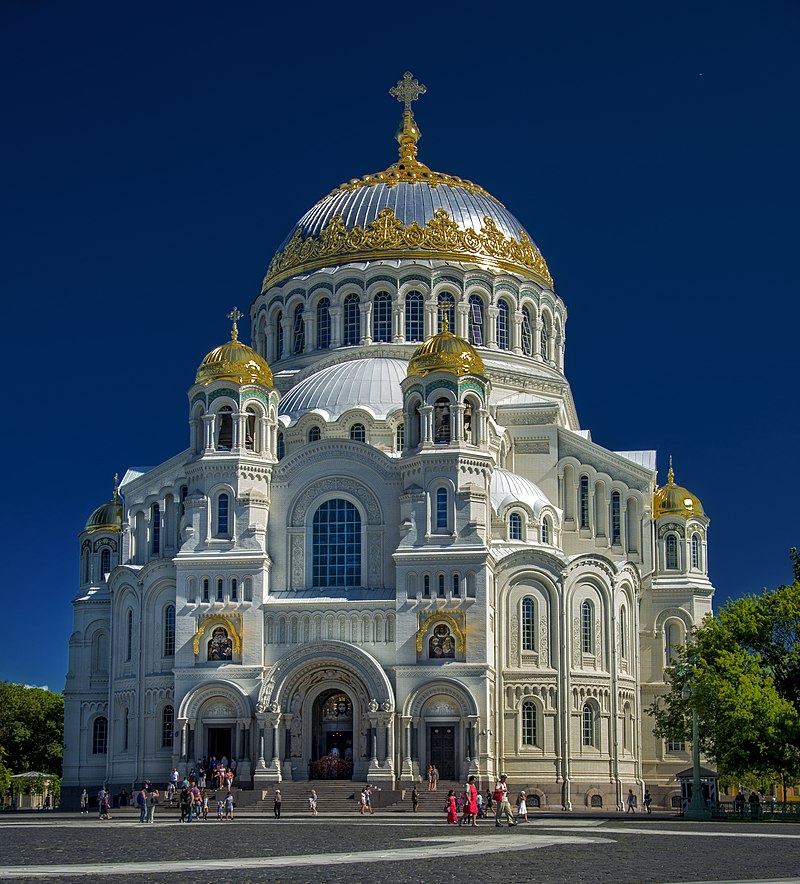
The Naval cathedral of Saint Nicholas in Kronstadt (Russian: Морской Никольский собор, Morskoj Nikol’skij sobor) is a Russian Orthodox cathedral built in 1903–1913 as the main church of the Russian Navy and dedicated to all fallen seamen. The cathedral was closed in 1929, was converted to a cinema, a House of Officers (1939) and a museum of the Navy (1980).
The Russian Orthodox Church reinstalled the cross on the main dome in 2002 and served the first Divine Liturgy in the cathedral in 2005.In 2013, the Patriarch of Russia, with Prime Minister Dmitriy Medvedev and his spouse attending, conducted the ceremony of grand reconsecration in the now fully restored cathedral.
克倫施塔特的聖尼古拉斯海軍大教堂(俄語:МорскойНикольскийсобор,Morskoj Nikol’skij sobor)是俄羅斯東正教大教堂,建於1903–1913年,是俄羅斯海軍的主要教堂,致力於所有墮落的海員。 大教堂於1929年關閉,改建為電影院,參議院(1939)和海軍博物館(1980)。
俄羅斯東正教教堂於2002年在主穹頂上重新安裝了十字架,並於2005年在大教堂裡擔任了第一位神職人員禮拜儀式.2013年,在首相德米特里·梅德韋傑夫(Dmitriy Medvedev)和他的配偶出席的俄羅斯先祖主持了大禮 現在完全恢復的大教堂。
Religion
Affiliation:Russian Orthodox
Location
Location:Yakornaya Square 1, Kronstadt, Saint Petersburg
Geographic coordinates:59°59′30.1546″N 29°46′40.3359″ECoordinates: 59°59′30.1546″N 29°46′40.3359″E
Architecture
Architect(s):Vasily Kosyakov
Style:Late Neo-Byzantine
Completed:1913
Specifications
Capacity:5,000
Length:77.3 m (interior)
83.2 m (exterior-stairs)
Width:54.4 m (interior)
63.8 m (exterior-stairs)
Interior area:3,000 m² (interior)
3,400 m² (exterior-stairs)
Height (max) 70.6 m (top cross)
Dome dia. (outer) 29.8 m
宗教
所屬:俄羅斯東正教
位置
位置:聖彼得堡,克朗施塔特,Yakornaya Square 1,
地理坐標:59°59′30.1546″ N 29°46′40.3359″ E坐標:59°59′30.1546″ N 29°46′40.3359″ E
建築
建築師:Vasily Kosyakov
風格:晚新拜占庭
已完成:1913年
技術指標
容量:5,000
長度:77.3 m(室內)
83.2 m(外部樓梯)
寬度:54.4 m(室內)
63.8 m(外部樓梯)
內部面積:3,000平方米(室內)
3,400平方米(室外樓梯)
高度(最大)70.6 m(上十字)
圓頂直徑 (外部)29.8 m
The first Orthodox church in Kronstadt was built in 1728–31. The wooden church remained the main place of worship in Russia’s largest naval base until 1840, when the counterweights balancing the church bells broke through the rotting floors and seriously damaged the belltower structure. Emperor Nicholas I personally ordered the closure of the unsafe church and it was demolished in 1841. For the next half century worship occurred in temporary locations — in hospitals, barracks and even rented private houses; a temporary wooden church built in 1861 was inadequate for the ten thousand Kronstadt seamen from the start. Numerous Navy requests for construction funding were turned down or simply left unanswered,despite the fact that the cost of building as large as a contemporary cathedral (200 to 500 thousand roubles) was less than 10% of a pre-dreadnought battleship’s cost (RUB4 to 6 million).
Construction management, extremely centralized until the reign of Alexander II, was gradually decentralized in the 1880s–1890s. The right to initiate individual construction projects passed from the Emperor himself to imperial ministers and department chiefs. In 1896 admiral Pavel Tyrtov, director of the Imperial Russian Navy Ministry, started preparations to build a cathedral in Kronstadt in earnest. Tyrtov insisted that the cathedral be built on the site identified nearly two centuries earlier by Peter I and reasoned that it should not cost more than the new Kharkov cathedral (200,000 roubles).
克倫施塔特(Kronstadt)的第一座東正教教堂建於1728–31年。直到1840年,木製教堂一直是俄羅斯最大的海軍基地的主要禮拜場所,當時平衡教堂鐘聲的配重突破了腐爛的地板,嚴重破壞了鐘樓的結構。尼古拉斯一世皇帝親自下令關閉不安全的教堂,並於1841年拆除。在接下來的半個世紀,朝拜活動發生在臨時場所,包括醫院,軍營甚至租用的私人房屋。從一開始,一間建於1861年的臨時木製教堂不足以容納一萬名克朗斯塔特海員。儘管事實證明,像一座現代大教堂一樣大的建築成本(200至50萬盧布)不到預畏級戰艦成本的10%(4盧布至40萬盧布),但許多海軍對建造資金的要求卻被拒絕或根本沒有得到解決。 600萬)。
在亞歷山大二世統治之前,建築管理一直處於高度集中的狀態,在1880至1890年代逐漸分散。發起個人建築項目的權利從皇帝本人轉給了帝國大臣和部門首長。 1896年,俄羅斯帝國海軍部部長帕維爾·季爾托夫(Pavel Tyrtov)上將著手準備在克朗施塔特(Kronstadt)建造一座大教堂。季爾托夫堅稱大教堂要建在彼得一世將近兩個世紀之前確定的地點上,並認為它的造價不應該超過新的哈爾科夫大教堂(200,000盧布)。
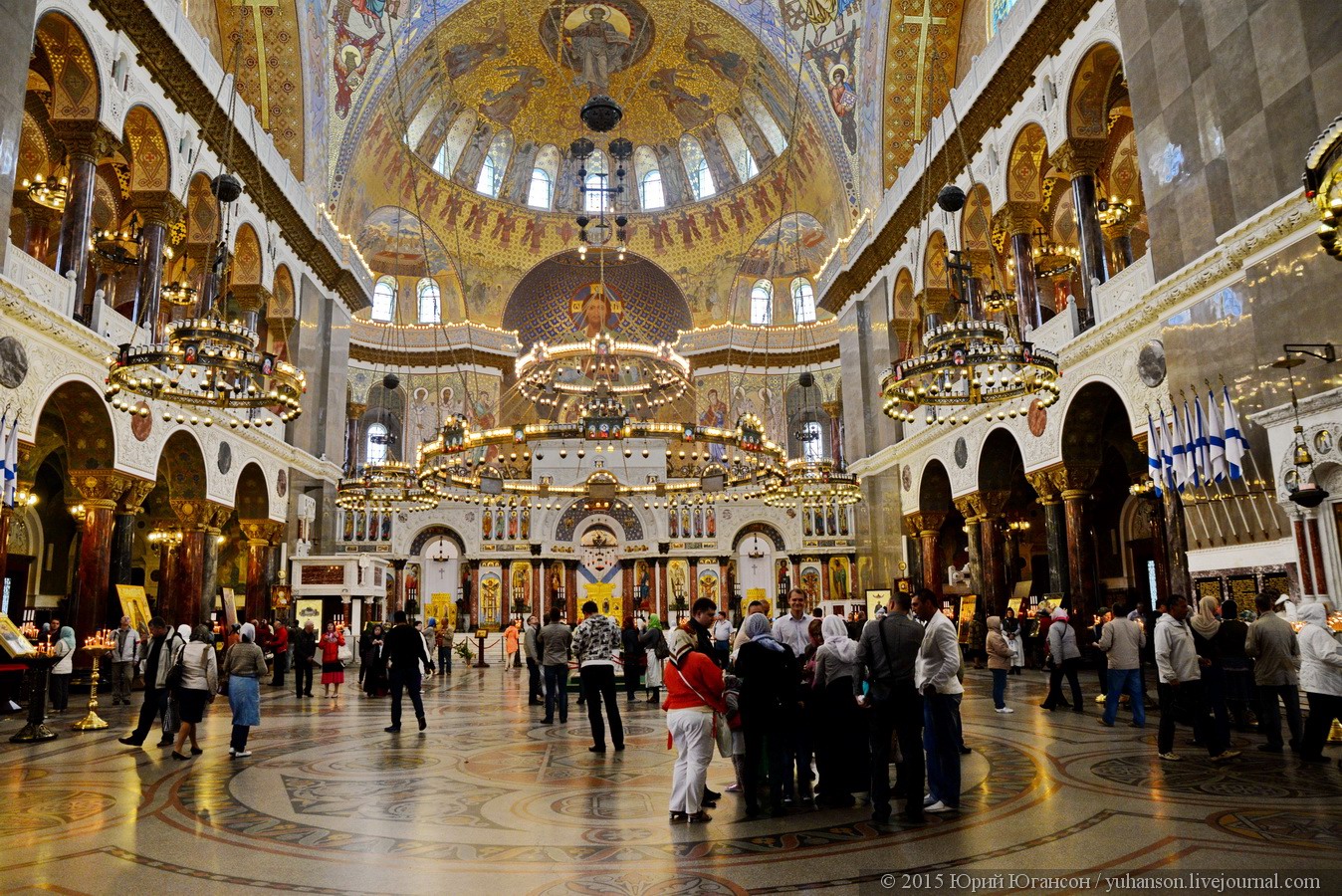
In 1897, the Navy declared an international architectural contest for the design of Kronstadt cathedral and established a fund to finance construction. Typically for Russia, the project was sponsored by the state, intended for the state Navy, but initially financed by personal donations of the Navy servicemen and general public. From 1898 to 1913, all servicemen of the Baltic Fleet were charged 1/400 of their salary to finance the construction; this amounted to 280 thousand roubles, not including truly voluntary donations. Later, as the project unfolded, it became obvious that private donations were insufficient and the state treasury paid for most of the costs.
The contest specified cathedral size in terms of number of worshippers — one thousand men, 16 per square sazhen. This was far smaller than contemporary cathedrals built in provincial towns (Nizhny Novgorod — 2,000 worshippers, Kharkiv — 4,000), more on par with “garrison churches” built in the Caucasus and Congress Poland (Kielce — 900 worshippers). The client was well aware of new construction technologies and welcomed their use as long as it helped to balance the budget. The basement level was reserved only for boilers and fuel storage, saving the costs of establishing a second “winter (i.e. heated) church”. The specifications did not prescribe a specific architectural style. Rather, they insisted on cutting costs and prohibited use of such “luxuries” as mosaics or paintings on the inner surface of the dome. These constraints failed the first contest. Only three architects dared to participate, reusing already familiar past drafts; all three were rejected.
The second contest of 1897 also failed; the only draft deemed worthy of execution was too small for the intended purpose. Finally, in 1898, the Navy lifted some of size and cost constraints; this time, the building had to be large enough to be visible from large distance; “the Cross of the cathedral must be the first item visible to incoming ships”. Antony Tomishko, author of Kresty prison, won this contest by presenting a Russian Revival draft following Konstantin Thon’s Russo-Byzantine tradition.
Nicholas II routinely approved the draft; John of Kronstadt called for immediate start of construction work. However, the newly appointed commander of Kronstadt base admiral Stepan Makarov found Tomishko’s draft too weak artistically and too small for the purpose. He requested the Emperor to reconsider his choice; after nearly two years of delays, Nicholas agreed to discard Tomishko’s draft in June 1900.
1897年,美國海軍宣布進行國際建築競賽,以設計克朗施塔特大教堂,並設立了一項基金來資助建設。通常在俄羅斯,該項目是由國家贊助的,旨在供國家海軍使用,但是最初是由海軍軍人和公眾的個人捐款資助的。從1898年到1913年,波羅的海艦隊的所有士兵都被收取薪水的1/400來資助建設。總額為28萬盧布,其中不包括真正的自願捐款。後來,隨著項目的開展,很明顯私人捐款不足,而國庫負擔了大部分費用。
競賽根據信徒人數指定大教堂的大小-一千名男子,每平方薩真16人。這遠遠小於省級城鎮中的當代大教堂(下諾夫哥羅德-2,000名信徒,哈爾科夫-4,000名),與在高加索和國會波蘭(基爾採-900名信徒)建造的“駐軍教堂”持平。客戶非常了解新的建築技術,並歡迎其使用,只要它有助於平衡預算即可。地下室僅保留用於鍋爐和燃料存儲,從而節省了建立第二個“冬季(即加熱的)教堂”的成本。規範沒有規定特定的建築風格。相反,他們堅持要削減成本,並禁止在圓頂的內表面使用諸如馬賽克或繪畫之類的“奢侈品”。這些限制使第一次比賽失敗了。只有三位建築師敢於參加,重用了已經熟悉的過去的草稿。這三個人都被拒絕了。
1897年的第二場比賽也失敗了。唯一值得執行的草案對於預期目的而言太小。最終,在1898年,海軍解除了一些規模和成本限制;這次,建築物必須足夠大才能從遠處看到。 “大教堂的十字架必須是新來的船隻可以看見的第一件物品”。克雷斯蒂監獄的作者安東尼·托米甚科(Antony Tomishko)憑藉康斯坦丁·托恩(Konstantin Thon)的俄羅斯-拜占庭式傳統提出了俄羅斯復興選秀,從而贏得了比賽。
尼古拉斯二世例行批准了該草案;克朗斯塔特(Kronstadt)的約翰呼籲立即開始建築工程。但是,新任命的克朗施塔特(Kronstadt)基地海軍少將史蒂芬·馬卡羅夫(Stepan Makarov)的指揮官發現,托米甚科的選秀藝術性太弱,太小了。他要求皇帝重新考慮他的選擇。經過近兩年的延誤,尼古拉斯同意在1900年6月放棄Tomishko的選秀權。
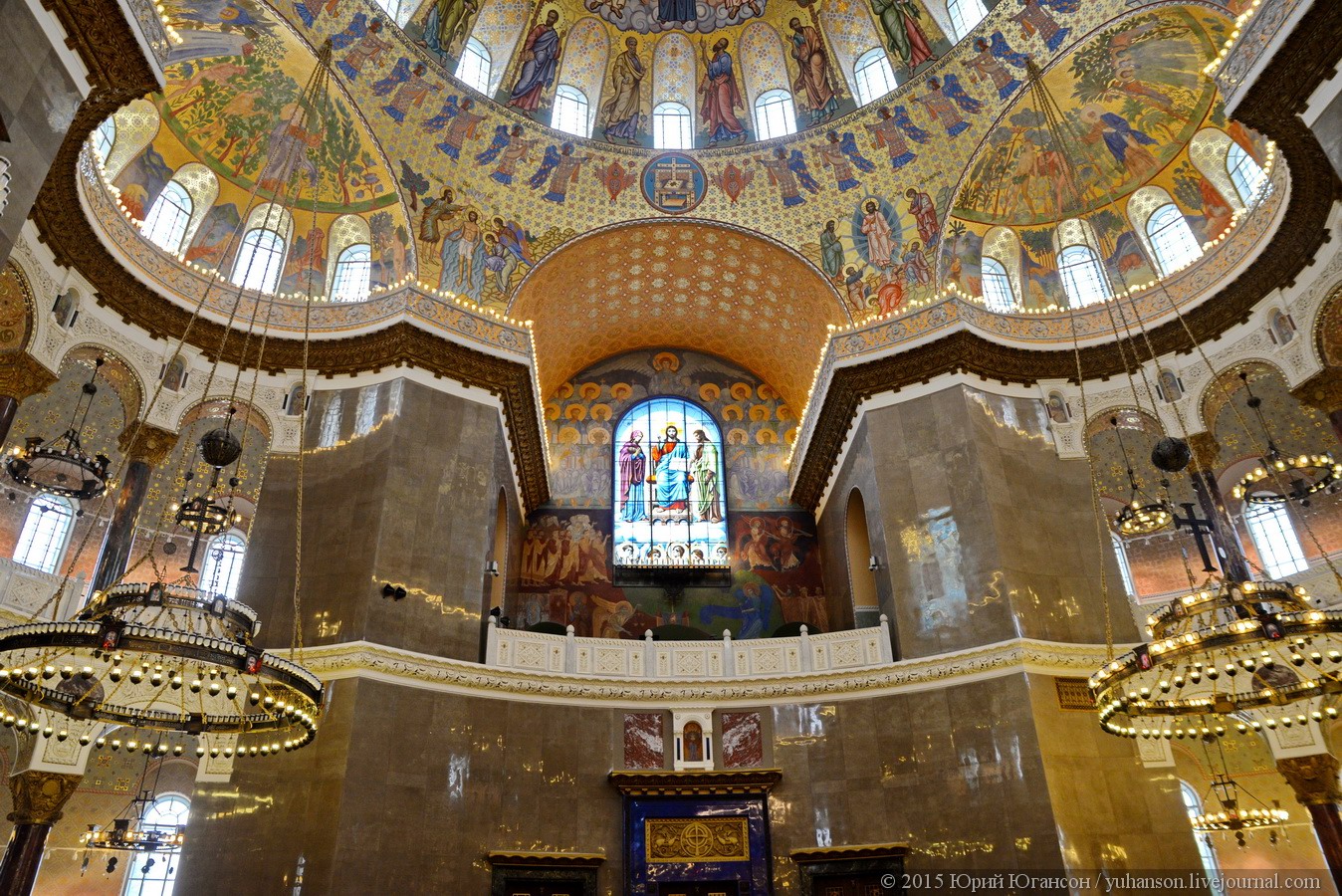
Makarov took control of the project and invited Vasily Kosyakov (1862–1921), already a renowned master of Neo-Byzantine architecture. The process of this choice remains undocumented, however, Kosyakov had worked for the Navy before as the architect of church of Our Lady the Merciful in Saint Petersburg. Kosyakov, still in his twenties, had perfected the optimal proportions of a single-dome, four-apse Byzantine design; his 1888–91 drafts of a church in Astrakhan (itself based on Our Lady the Merciful) were reused all over the Empire. Vasily’s younger brother and partner Georgy Kosyakov (1872–1925) was a talented graphic artist; he worked on interiors and finishes while Vasily handled overall and structural design. Makarov personally instructed Kosyakov that the cathedral must accommodate 5,000 worshippers and follow the historical Byzantine canon.
In 1900–1, Vasily Kosyakov travelled to Istanbul and Greece to refresh his understanding of genuine Byzantine art. In April 1901, he presented two preliminary drafts to the Commission of the Navy; the selected draft was approved by Nicholas II 21 May 1901. Kosyakov departed from his preferred proportions of a tall cathedral with a relatively small main dome; instead he opted for a wide (26 meters) but relatively low dome in line with the proportions of Hagia Sophia. The reason for this change remains undocumented. One version attributes it to interference by Makarov. The admiral once was an attache in Istanbul and was well aware of the genuine Byzantine tradition. Another likely version links the change to direct influence of professor Nikolay Sultanov, Kosyakov’s teacher at the Institution of Civil Engineers, leader of Russian Revival school. In 1895–1904, Kosyakov was managing the construction of Cathedral of Saints Peter and Paul in Peterhof designed by Sultanov.
By 1903, Kosyakov brothers produced a complete album containing nearly a thousand graphic sheets detailing the structure, exterior and internal design of yet unbuilt cathedral. Physically, the graphics were executed by Georgy Kosyakov. Plan, structure, external outline is credited to Vasily Kosyakov; detailed artwork of interior finishes to Georgy. Interior features were clearly influenced by Art Nouveau, skillfully integrated into a Byzantine shell and complemented with modern engineering systems. Vasily Kosyakov’s layout also demonstrates influence of Romanesque architecture, notably in the twin belltowers by the sides of the main portal — an extremely uncommon feature in Russian practice.
馬卡洛夫(Makarov)接手了該項目,並邀請了已經是新拜占庭式建築大師的瓦西里·科斯雅科夫(1862-1192)。這種選擇的過程尚無記錄,但是,科沙科夫曾在海軍工作過,曾擔任聖彼得堡聖母憐憫教堂的建築師。二十多歲的科雅科夫(Kosyakov)完善了單穹頂,四頂點拜占庭式設計的最佳比例。他1888-91年在阿斯特拉罕建立的教堂草稿(本身基於仁慈的聖母)在整個帝國中都得到了重新使用。瓦西里(Vasily)的弟弟和伴侶喬治(Georgy Kosyakov)(1872-1925)是一位才華橫溢的圖形藝術家。他從事室內設計和裝飾工作,而瓦西里則負責整體和結構設計。馬卡羅夫親自指示科沙科夫,大教堂必須容納5,000名信徒,並遵循歷史悠久的拜占庭教規。
1900–1年,瓦西里·科雅科夫(Vasily Kosyakov)前往伊斯坦布爾和希臘,以重新了解真正的拜占庭藝術。 1901年4月,他向海軍委員會提交了兩個初步草案。選定的草案經1901年5月21日的尼古拉斯二世批准。科西亞科夫偏離了他偏愛的高圓頂大教堂(主圓頂相對較小)的優先比例;相反,他選擇了寬廣(26米)但相對較低的圓頂,以符合聖索菲亞大教堂的比例。更改的原因仍未記錄。一個版本將其歸因於Makarov的干預。這位海軍上將曾經是伊斯坦布爾的公務員,並且深知真正的拜占庭傳統。另一個可能的版本將這一變化與俄羅斯復興學校負責人,土木工程師學會科索亞科夫老師尼古拉·蘇爾塔諾夫教授的直接影響聯繫起來。 1895年至1904年,科索科夫負責管理由蘇丹阿諾夫(Sultanov)設計的彼得霍夫(Peterhof)的聖彼得大教堂和聖保羅大教堂。
到1903年,科希亞科夫兄弟製作了一張完整的專輯,其中包含近千張圖形紙,詳細介紹了尚未建成的大教堂的結構,外觀和內部設計。從物理上講,這些圖形是由Georgy Kosyakov執行的。計劃,結構,外部輪廓歸功於Vasily Kosyakov;喬治的室內裝飾的詳細藝術品。內部特徵顯然受到了新藝術運動的影響,被巧妙地整合到拜占庭的外殼中,並輔以現代工程系統。瓦西里·科雅科夫(Vasily Kosyakov)的佈局還展示了羅馬式建築的影響力,特別是在主入口兩側的雙鐘樓中-這在俄羅斯實踐中是極為罕見的特徵。
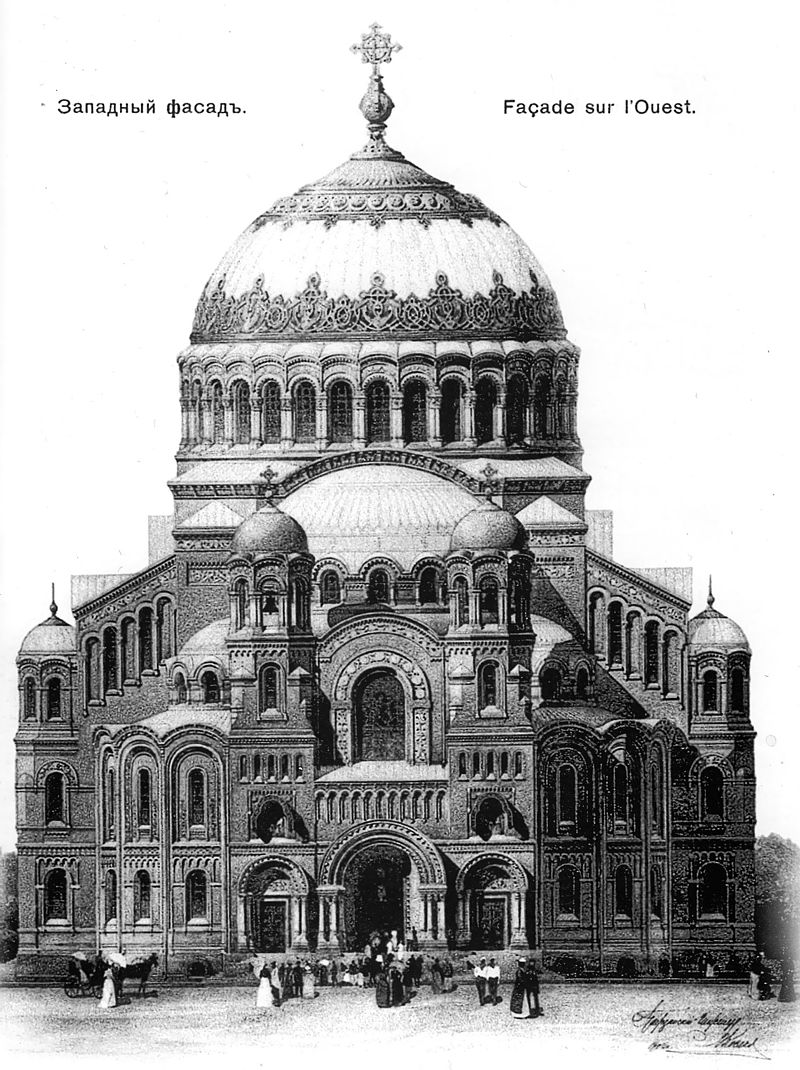
Western (main) facade
Vasily Kosyakov
西(主)門面
瓦西里·科雅科夫(Vasily Kosyakov)
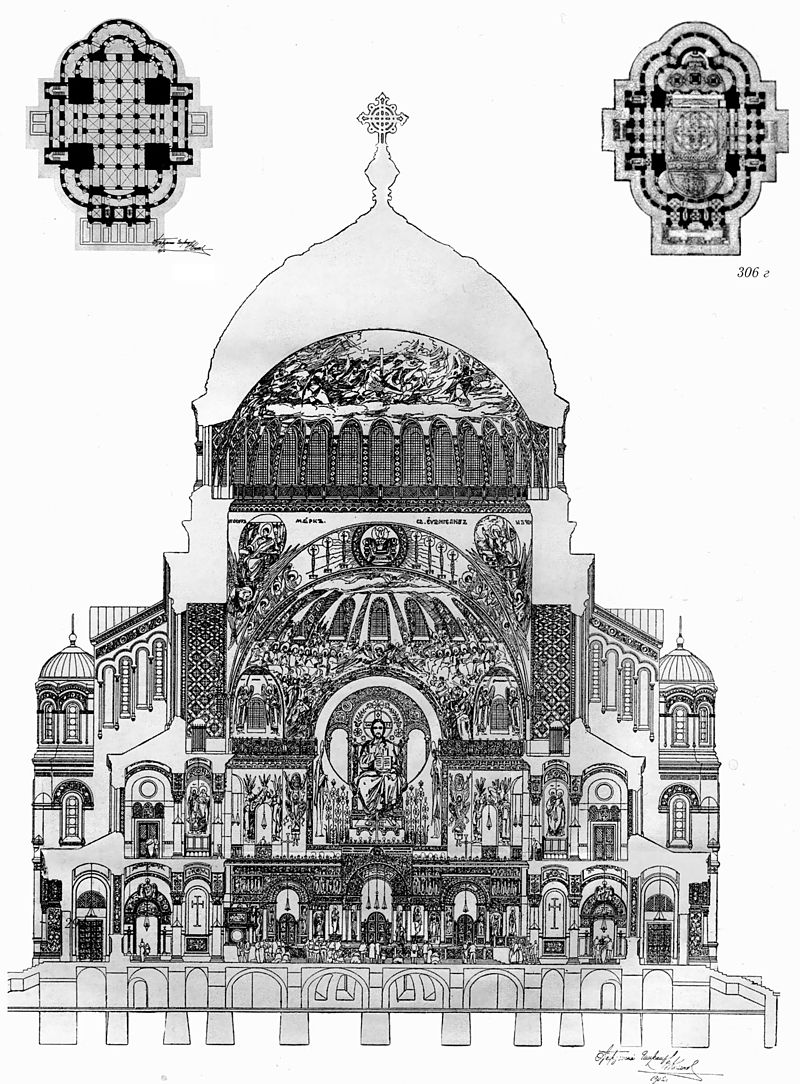
Structural cutaway
Vasily Kosyakov
結構剖面圖
瓦西里·科雅科夫(Vasily Kosyakov)
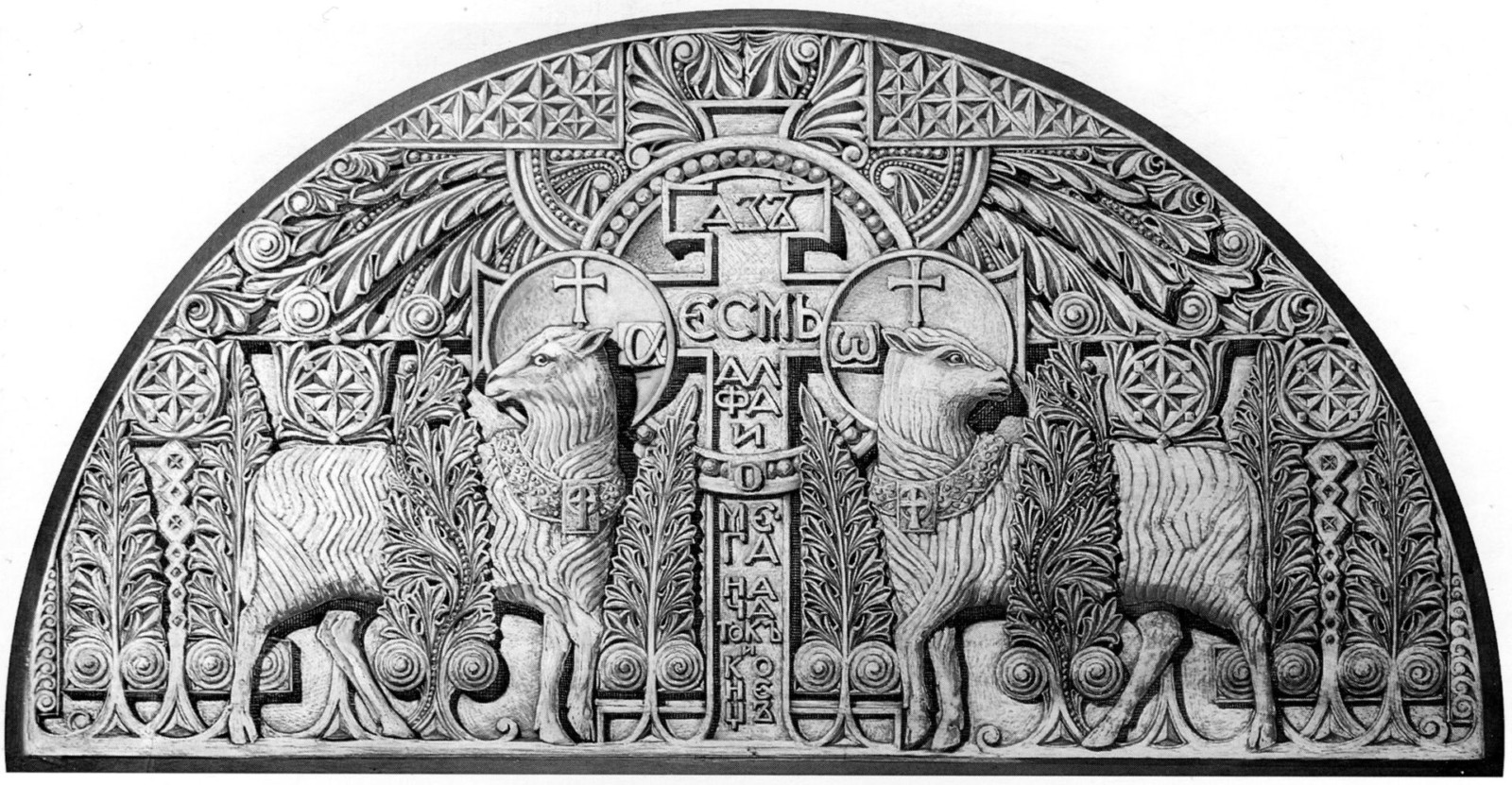
Alpha and Omega artwork
Georgy Kosyakov
阿爾法和歐米茄藝術品
喬治·科西亞科夫(Georgy Kosyakov)

Ritual chandeliers
Georgy Kosyakov
儀式吊燈
喬治·科西亞科夫(Georgy Kosyakov)
27 October 1901, the 14,000 strong garrison of Kronstadt was summoned for the groundbreaking on Anchor Square. Earthwork and work on concrete foundations and a granite base continued through 1902; the walls were laid in a massive ceremony 8 May 1903, with the Emperor in attendance.
Despite social unrest that culminated in the Russian revolution of 1905, the cathedral was structurally complete in 1907; heating and ventilation were operational in 1908, enabling year-round work on the finishes. In 1907, Kosyakov brothers switched to producing detailed drawings and instructions to craftsmen and suppliers of interior finishes. 19 August 1908, they presented the revised album of these drawings to the Romanovs. Nicholas and Alexandra responded with numerous amendments and changes that were implemented by spring of 1909.
In summer of 1909 the external finishes were completed, and the scaffolds removed. The building was clad in black granite (base and columns) and yellow brick (walls) with terra cotta inserts. Inside, the iconostasis was made of marble from the Urals. The four portals were decorated with mosaic images of Theotokos, Saint Nicholas, Peter, Paul, John of Rila and Mitrofan of Voronezh by Foma Raylian. Most interior paintings were executed by the school of Mikhail Vasilyev; icons were painted by Appolon Troitsky. Adjacent park was designed by E. G. Gilbikh.
The cathedral was equipped with an independent central heating and a central vacuum cleaning system employing a complex network of pressurized manifolds and valves. Electrical lighting employed 5 thousand light bulbs.
The cathedral was consecrated in a public ceremony attended by Nicholas II and his family 10 June 1913. Total cost reached an unprecedented amount of 1,955,000 roubles, not including donations in kind and unpaid labor by the seamen and civilians.
1901年10月27日,14,000名堅守的克倫施塔特駐軍因在錨廣場上的開工而被召喚。土方工程,混凝土基礎和花崗岩基地的工程一直持續到1902年;牆壁是在1903年5月8日舉行的大規模儀式上鋪設的,皇帝出席了儀式。
儘管社會動盪在1905年的俄國革命中達到頂峰,但大教堂在1907年結構完整。加熱和通風設備於1908年投入運營,可以對整飾進行全年的工作。 1907年,科希亞科夫兄弟轉而製作詳細的圖紙和說明,以向手工業者和室內裝飾供應商提供。 1908年8月19日,他們向羅曼諾夫夫婦贈送了這些圖紙的修訂專輯。尼古拉斯(Nicholas)和亞歷山德拉(Alexandra)做出了許多回應,並於1909年春季實施了許多修改和變更。
1909年夏天,外部裝修完成,腳手架被拆除。這座建築被黑色花崗岩(底部和圓柱)和黃色磚(牆壁)覆蓋著,上面有兵馬俑嵌件。在內部,聖障由烏拉爾山脈的大理石製成。 Foma Raylian分別用Theotokos,Saint Nicholas,Peter,Paul,Rila的John和Voronezh的Mitrofan的馬賽克圖像裝飾了四個門戶。大多數室內畫是由米哈伊爾·瓦西里耶夫(Mikhail Vasilyev)學校執行的;圖標由Appolon Troitsky繪製。毗鄰公園由E. G. Gilbikh設計。
大教堂配備有獨立的中央供暖系統和中央真空清潔系統,該系統使用複雜的加壓歧管和閥網絡。電氣照明使用了5000個燈泡。
大教堂在1913年6月10日的尼古拉斯二世及其家人參加的公開儀式上被奉獻。總成本達到了史無前例的1,955,000盧布,其中還不包括海員和平民的實物捐贈和無償勞動。
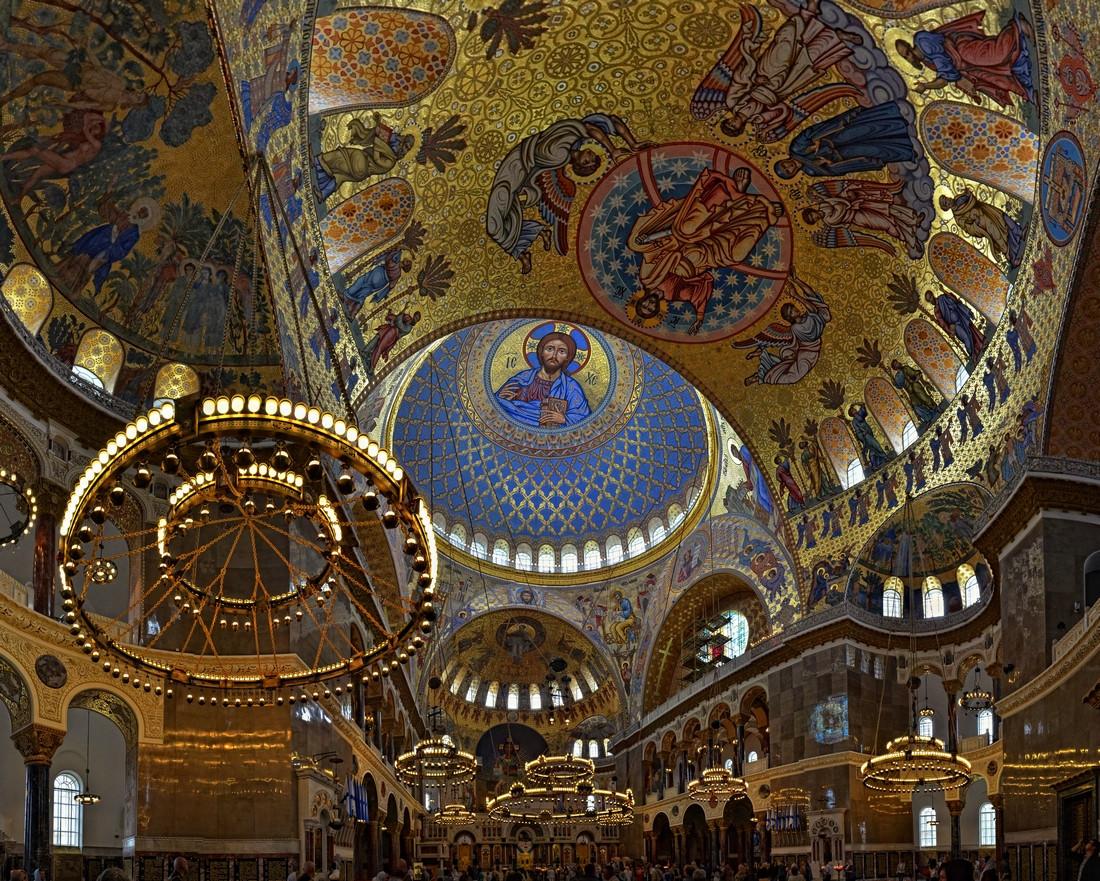
The cathedral operated as such for only 16 years. It was closed 14 October 1929 by the communist regime and its valuables were nationalized to the state treasury. A small portion of these relics were displayed at the Museum of Navy and the Russian Museum.
In 1930—1931 the communist authorities had the cathedral defaced: its crosses and bells were toppled over and hauled to the foundries. One bell, weighing 4,726 kilograms (second largest) remained in place — either due to technical difficulties or deliberately, as an emergency alarm signal. Internal marble items, including the iconostasis and the memorial boards with names of the fallen seamen, were ripped out, broken or cut and reused for ordinary construction needs. A small number of memorial boards ended up in the Museum of Navy and were “written off” in 1970.
In 1932 the cathedral nave was converted to a cinema, frivolously named New Star (in English, transliterated in Cyrillic) but soon renamed to more appropriate Maxim Gorky; in 1939 the cinema was upgraded to a House of the Officers (akin to a community center) of Kronshtadt garrison. During World War II it closed; the dome received three direct artillery hits. Post-war “reconstruction” of 1953—54 finally converted the cathedral to a functioning concert hall. This time, the builders added a suspended ceiling that isolated the nave from the dome; it remained in place as of the end of 2007. Reduction of military personnel in the 1960s made the concert hall redundant; in 1980 the cathedral reopened as a branch of the Central Museum of Navy.
The Russian Orthodox Church attempted to repossess the cathedral in the 1990s. The first cross to be reinstalled on the main dome was made in 1996 but was not erected due to financial problems. The second attempt, in 2002, employed a heavy helicopter and nearly ended in a disaster: the seven-meter cross fell from the dome and was damaged beyond repair; there were no human injuries. The third cross was successfully erected 24 November 2002. Three years later, 2 November 2005, the church celebrated the first Divine Liturgy in the Naval Cathedral since 1929. In September 2008 the cathedral became operational again, but services were only conducted on special occasions.
The cathedral then underwent extensive repairs, restoration, and improvements, and was reconsecrated on 30 May 2013, by Patriarch Cyril, in time for the cathedral’s centennial anniversary. In his remarks at the reconsecration, Russian president Dmitry Medvedev said the cathedral looked “better than 100 years ago.”
大教堂僅運作了16年。 1929年10月14日,它被共產主義政權關閉,其貴重物品被國有化為國庫。這些文物的一小部分在海軍博物館和俄羅斯博物館展出。
在1930年至1931年,共產黨當局毀壞了大教堂:教堂的十字架和鍾聲被推倒並拖向鑄造廠。由於技術困難或故意將一鈴重達4,726公斤(第二大鈴)作為緊急警報信號。內部大理石製品,包括聖障和帶有墮落海員名字的紀念板,被拆除,破碎或切割後再用於普通建築需要。少數紀念板最終出現在海軍博物館,並於1970年“註銷”。
1932年,大教堂的中殿改建為戲院,輕率地命名為“新星”(英語,以西里爾字母音譯),但不久後改名為“馬克西姆·高爾基”。 1939年,電影院升格為克朗施塔特駐軍的官邸(又稱為社區中心)。在第二次世界大戰期間,它關閉了;圓頂受到三門直接砲擊。戰後1953年的“重建” — 54終於將大教堂改建為功能良好的音樂廳。這次,建築商增加了一個吊頂,將中殿與圓頂隔離開來。到2007年底,它仍然存在。1960年代軍事人員的減少使音樂廳變得多餘。 1980年,大教堂作為中央海軍博物館的一個分支重新開放。
俄羅斯東正教試圖在1990年代收回大教堂。第一個要在主穹頂上重新安裝的十字架是在1996年製作的,但由於財務問題而沒有架起。第二次嘗試是在2002年使用了一架重型直升機,幾乎以一場災難告終:七米高的十字架從穹頂上墜落,損壞得無法修復。沒有人受傷。第三個十字架於2002年11月24日成功豎立。三年後,2005年11月2日,該教堂自1929年以來在海軍大教堂慶祝了第一個神職人員禮拜儀式。2008年9月,該大教堂再次投入使用,但僅在特殊場合提供服務。
然後對大教堂進行了大修,修復和改善,並於2013年5月30日由西里爾牧師(Patrick Archy Cyril)對其進行了修復,以紀念大教堂成立100週年。俄羅斯總統德米特里·梅德韋傑夫(Dmitry Medvedev)在致敬儀式時說,大教堂看起來“比100年前更好”。
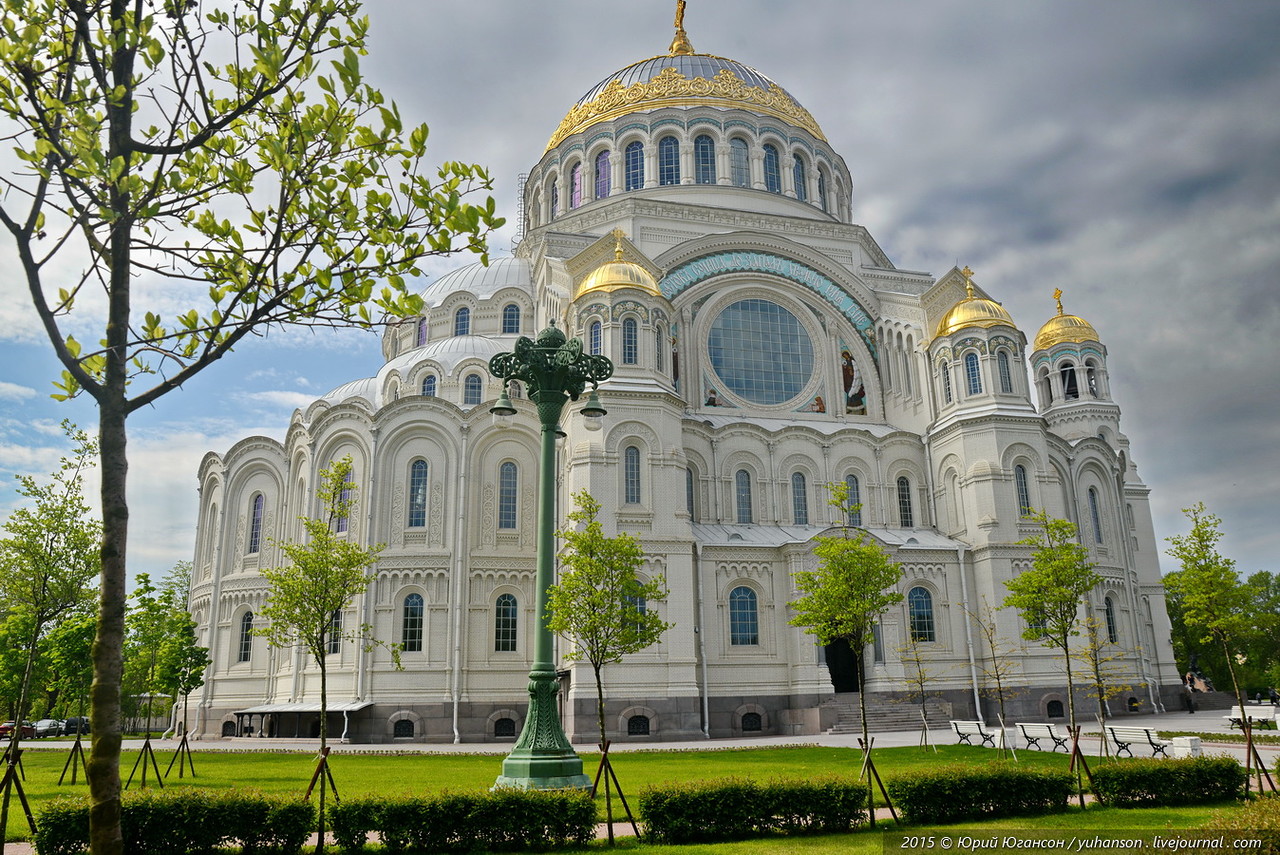
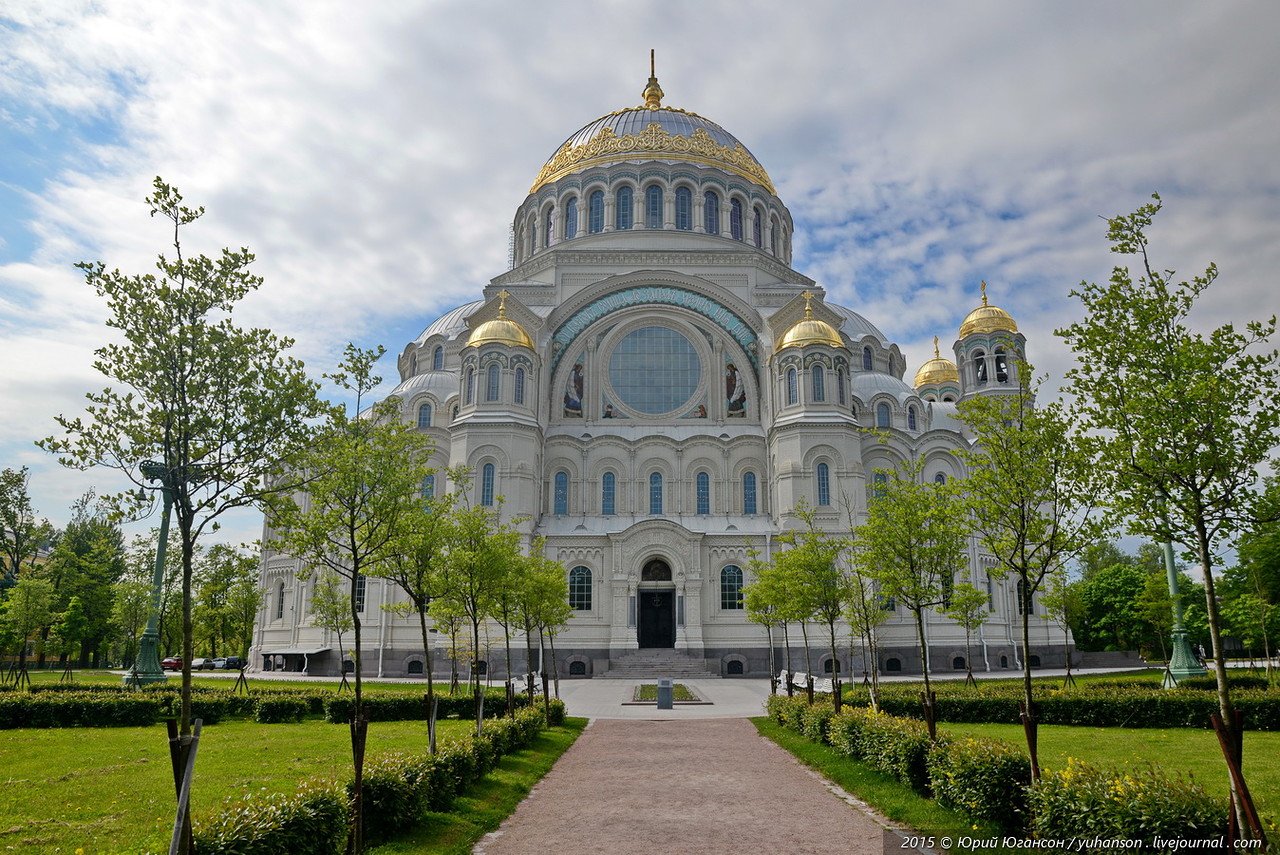
FROM:https://en.wikipedia.org/wiki/Kronstadt_Naval_Cathedral
FROM:Kronstadt Naval Cathedral
FROM:Kronstadt Naval Cathedral of Saint Nicholas.
FROM:Kronstadt Naval Cathedral, Saint Petersburg-Russia
Don’t you think it’s addictive?
Want to know more about the beauty of architecture?
Come and join our members to explore the beauty of architectural design.
覺得看得不過癮嗎?
想要知道更多建築之美嗎?
快來加入我們的會員,一同探索建築設計之美。
The above article is purely for appreciation and sharing purposes, as well as the construction of new technology and the public can be in-depth understanding of the information at the same time there are sources, will be able to query, no use of the document as a commercial transaction, if illegal, please inform the We will immediately remove the site, thank you for cooperation.
以上文章純粹作為欣賞及分享用途,以及將建築新型技術傳遞給與大眾能夠深入了解,同時資料還有來源,將可查詢,絕無使用該文件資料作為商業交易行為,如有違法請務必告知該網站我們將立即處理撤除,謝謝合作。

